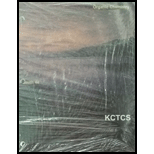
Interpretation:
To explain why (CH3)2CHCH(Br) CH2CH3 reacts faster than (CH3)2CHCH2CH(Br) CH3 in an E2 reaction.
Concept introduction:
The most common mechanism for dehydrohalogenation is the E2 mechanism. An E2 reaction exhibits a second-order kinetics, in which the reaction is bimolecular and both the
The transition state of an E2 reaction consists of four atoms from the alkyl halide-one hydrogen atom, two carbon atoms, and the leaving group (X)-all aligned in the same plane. There are two ways for the C-H and C-x bonds to be coplanar. When the H and X atoms oriented on the same side of the molecule. This geometry is called syn periplanar. While the H and X atoms oriented on opposite sides of the molecule. This geometry is called anti periplanar. The dihedral angle for the C-H and C-X bonds equals 0° for the syn periplanar arrangement and 180° for the anti periplanar arrangement.
Trending nowThis is a popular solution!

Chapter 8 Solutions
KCTCS Organic Chemistry Value Edition (Looseleaf) - Text Only
- From each pair, select the stronger nucleophile. Q.) CH3OCH3 or CH3SCH3arrow_forwarda. Which reacts faster in an E2 reaction: 3-bromocyclohexene or bromocyclohexane?b. Which reacts faster in an E1 reaction?arrow_forwardGiven that an E2 reaction proceeds with anti periplanar stereochemistry, draw the products of each elimination. The alkyl halides in (a) and (b) are diastereomers of each other. How are the products of these two reactions related?arrow_forward
- Which reacts faster in an E2 reaction: 3-bromocyclohexene or romocyclohexane? a. Which reacts faster in an E1 reaction?arrow_forwardGiven that an E2 reaction proceeds with anti periplanar stereochemistry, draw the products of each elimination. The alkyl halides in (a) and (b) are diastereomers of each other. How are the products of these two reactions related? Recall from Section 3.2A that C6H5 −is a phenyl group, a benzene ring bonded to another group.arrow_forwardGiven that an E2 reaction proceeds with anti periplanar stereochemistry, draw the products of each elimination. The alkyl halides in (a) and (b) are diastereomers of each other. How are the products of these two reactions related? Recall from Section 3.2A that C6H5– is a phenyl group, a benzene ring bonded to another group.arrow_forward
 Organic Chemistry: A Guided InquiryChemistryISBN:9780618974122Author:Andrei StraumanisPublisher:Cengage Learning
Organic Chemistry: A Guided InquiryChemistryISBN:9780618974122Author:Andrei StraumanisPublisher:Cengage Learning
